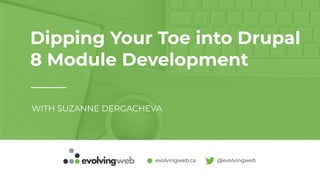
Dipping Your Toe into Drupal 8 Module Development
- 1. evolvingweb.ca @evolvingweb Dipping Your Toe into Drupal 8 Module Development WITH SUZANNE DERGACHEVA
- 2. • Co-founded Evolving Web in 2007 • Experienced Drupal themer, developer, project lead • Loves teaching DrupalSuzanne Dergacheva CO-FOUNDER AND FRONT-END LEAD
- 3. Creating great websites with Drupal TRAINING WEB DEVELOPMENT WEB CONSULTING
- 4. Some of our happy clients
- 5. Should I Create a Module? PROS • You get a flexible solution • Might be simpler than installing a complex module CONS • Takes time/skills to develop • You have to maintain the code • Can introduce bugs
- 6. Simple Module Examples • Change a form • Add a programmatic block • Add a programmatic page • Add a menu link • Create a field formatter • Add custom validation
- 7. Before You Start • Use the local.settings.php file and development.services.yml files (https://www.drupal.org/node/2598914) • Enables errors and warnings • Disables some caching • Disables aggregation of CSS/JS • Install the Devel module • Make sure your editor has syntax highlighting set up
- 8. Step 1: Research • Is there already a module that does this? • If not, is there something similar. Look for an example: • Drupal core • Contrib modules • Examples module • Try and find the code that does the thing you want • Figure out how it integrates with Drupal (usually a hook or a Class)
- 9. Step 2: Create the Scaffolding • Use the Drupal Console to write the scaffolding code or use examples from other modules to see what structure you need • Create a module folder, and an .info.yml file • Then, add a Class or hook to your module drupal generate:module drupal generate:controller
- 10. Step 3: Fill in the Custom Code • Write the logical part of your code that does the custom work • Look for exmaples of what you’re trying to do • You can copy and paste code snippets • … But make sure you read/understand each line of code!
- 11. Step 4: Testing • Easy to forget to test when you’re doing something simple • QA Tips: • Read error messages • Make sure you understand what you’re testing (what is supposed to change on the site) • Also test that your code doesn’t break other use cases. You might need to add an ‘if’ statement
- 12. Essential Terminology • Yml - File format used to define modules/theme, permissions, paths, menu items, and exported configuration • Class - Group of properties and methods that define an object. Used to extend parts of Drupal so you can create your own Forms, Blocks, Fields, Entities, Webform Elements, etc. • Plugin - Class that is ‘discoverable’ by Drupal. Examples: Blocks, Fields • Hook - Function that allows you to alter how something works in Drupal. Examples: altering forms, emails, adding things to cron
- 13. Let’s Build a Module
- 15. Link to the Edit Account Page
- 16. Link to the Edit Account Page • Define a new path • The path points to a Controller • The controller redirects you to the path /user/[uid] but fills in the uid of the current User drupal generate:controller drupal generate:module
- 17. Changing a Form
- 18. Changing a Form • Find the form ID • Implement hook_form_alter • Add/remove/update elements of the form • Use this reference: https://api.drupal.org/api/drupal/elements/8.2.x drupal generate:form:alter drupal generate:module
- 20. Next Steps • Drupal Docs for Creating Custom Modules: https://www.drupal.org/ docs/8/creating-custom-modules • Try this tutorial: https://www.drupal.org/docs/8/creating-custom- modules/a-hello-world-custom-page-module • Download the Examples module: http://drupal.org/project/examples
- 21. Upcoming Drupal Trainings MAY 7-11, IN-PERSON Drupal 8 Training in Princeton NJ FEB 5-8, ONLINE Drupal 8 Module Development FEB 20-23, ONLINE Migrate to Drupal 8 MARCH 1-2, ONLINE Drupal 8 Site Building MARCH 12-15, ONLINE Drupal 8 Theming evolvingweb.ca/training training@evolvingweb.ca
